The Centre for Regulatory Research and Innovation
Food landscapes are changing at a rapid pace.
These changes are challenging stakeholders across food systems to adopt the use of new technologies, processes and ingredients to provide foods that align with consumer expectations, but also with Government priorities.
Regulation and policies have touchpoints throughout the food system, from the production of commodities to the retail-destined end-products offered to consumers.
For the Canadian plant protein and food ecosystem to be effectively aligned with domestic and global priorities, it is essential that regulations and policies create an enabling environment that facilitates utilization in national and international markets.
Similar to other jurisdictions, Canadian regulations and policies related to food are based on strong and robust data, while protecting and facilitating the health and food security of Canadians.
Working collaboratively across Canada’s food system, the Centre for Regulatory Research and Innovation (CRRI) will aim to create an environment of meaningful dialogue between stakeholders and ensure that assessments of regulations and policy are informed by objective and responsible analysis of the challenges, opportunities, and risks associated with current or proposed regulatory and policy amendments.
Concurrently, the CRRI will lead research initiatives and experimentation to create datasets and address data gaps required to inform, modernize, and implement regulatory and policy frameworks relevant to Canada’s plant food ecosystem.

Vision
Cultivate an agile food system in Canada with regulatory and policy frameworks that are globally recognized as a model for the seamless integration of plant protein into healthy and sustainable dietary patterns
Mission
Lead, collaborate and support initiatives that facilitate the development, modernization and application of regulations and policies that advance the successful growth of Canada's plant protein sector.
Objectives
- Engage with food and agriculture industry stakeholders to navigate domestic and international regulations and policies to mitigate risks, address challenges and present opportunities for growth and differentiation.
- Create an enabling regulatory and policy environment for the plant protein sector through collaborative engagement with domestic and international government agencies.
- Initiate and collaborate on research that facilitates the application, creation and/or modernization of regulations and policies that support Canada’s plant protein ecosystem.
Discussing Canada's regulatory environment
Research and Collaborative Work
The effects of grinding and pelleting on nutrient composition of Canadian pulses
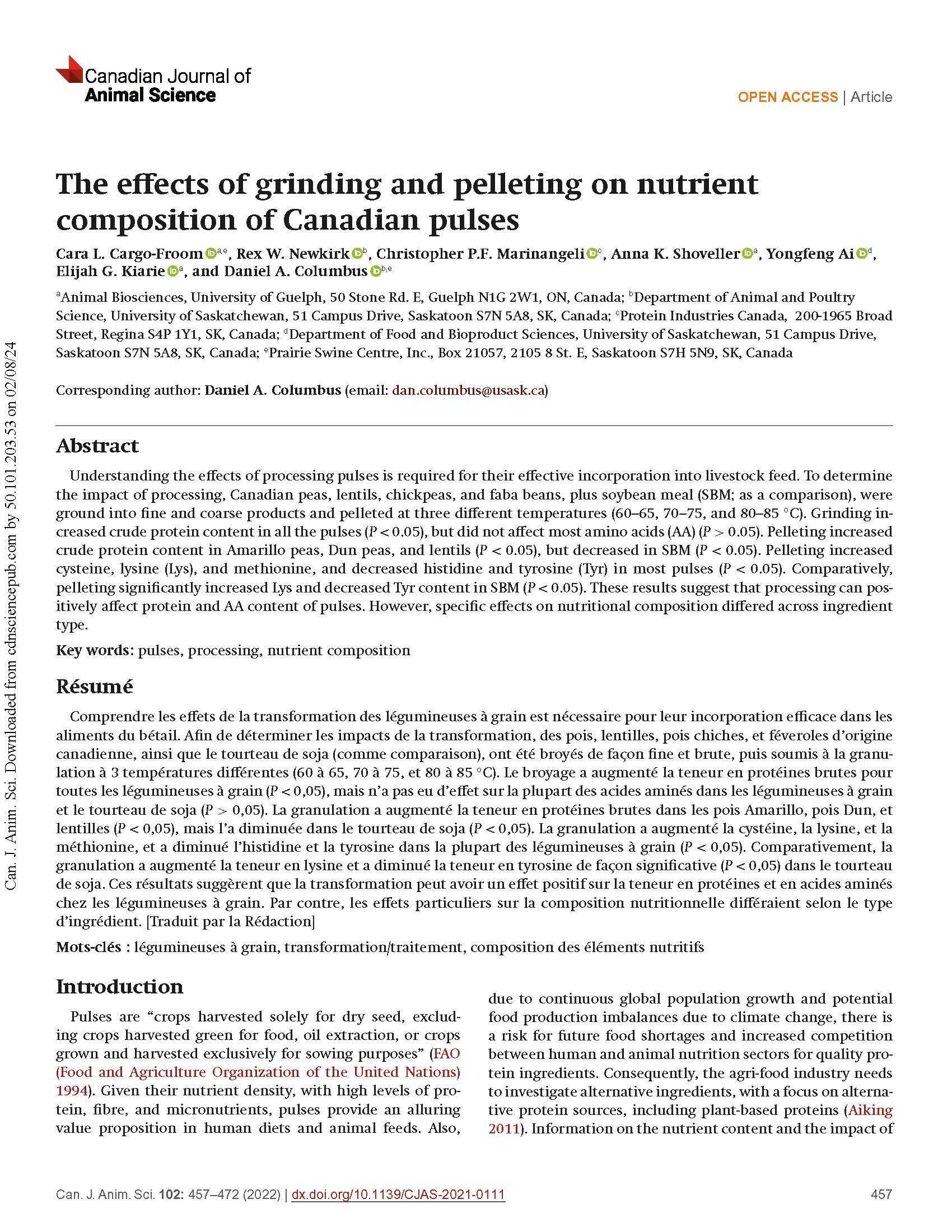
Pulses are increasingly valued as nutritious and sustainable feed ingredients. Data regarding the effects of pelleting on the nutrient composition of Canadian pulses are required for their effective integration into animal feed products. This study systematically evaluated the effects of grinding and temperature on the nutrient composition of pelleted Canadian peas, chickpeas, faba beans, and lentils. Results from this study suggest that processing can positively affect protein and amino acid content of pulses. However, specific effects on nutritional composition differed across pulse types.
Funding: Swine Innovation Porc, Saskatchewan Pulse Growers, and MITACS Accelerate
Reference: Cara L. Cargo-Froom, Rex W. Newkirk, Christopher P.F. Marinangeli, Anna K. Shoveller, Yongfeng Ai, Elijah G. Kiarie, and Daniel A. Columbus. 2022. The effects of grinding and pelleting on nutrient composition of Canadian pulses. Canadian Journal of Animal Science. 102(3): 457-472.
Why this is important
These data will help accelerate the use of Canadian plant protein sources, such as pulses, across Canadian and international markets. These types of data are important for creating a strong value proposition for Canada’s plant protein industry for the safe and effective use of nutrient-dense, sustainable protein ingredients subjected to variable processing technologies for use in animal feed.
The effects of extrusion on nutrient content of Canadian pulses with a focus on protein and amino acids
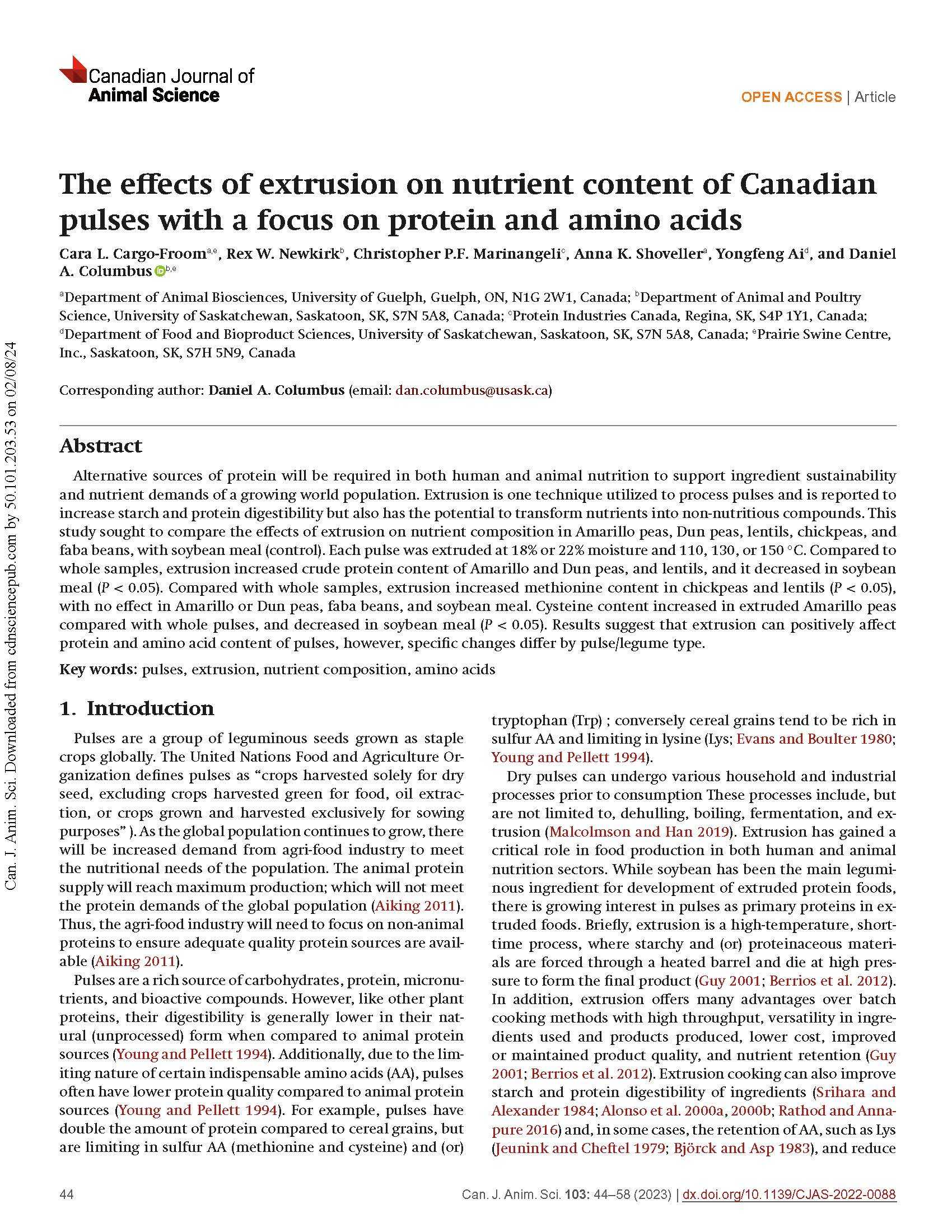
As the need for alternative protein sources emerges, interest in the incorporation of other legumes, such as pulses, into extruded food products has developed. Information on the nutrient content and impact of common processing techniques of Canadian pulses will be critical to increasing their use as alternative proteins in both human and animal nutrition. Thus, the objectives of this study were to characterize the nutrient content, determine the effects of processing by extrusion on nutrient composition, and compare samples extruded at different moistures/temperatures in Canadian peas, chickpeas, lentils, and faba beans. Results from this study showed that can positively affect protein and amino acid content of pulses, however, specific changes differ by pulse/legume type.
Funding: Swine Innovation Porc, Saskatchewan Pulse Growers, and MITACS Accelerate
Reference: Cara L. Cargo-Froom, Rex W. Newkirk, Christopher P.F. Marinangeli, Anna K. Shoveller, Yongfeng Ai, and Daniel A. Columbus. 2023. The effects of extrusion on nutrient content of Canadian pulses with a focus on protein and amino acids. Canadian Journal of Animal Science. 103(1): 44-58.
Why this is important
Broadening the utilization of plant protein foods in animal diets can improve the environmental sustainability attributes of Canada’s plant protein sector. Understanding the effects of processing on protein quality attributes, including the levels of amino acids, of Canadian plant proteins will expedite and de-risk the use of these ingredients as a protein source in animal feed and create new opportunities for growth.
Processing effects on the starch and fibre composition of Canadian pulses
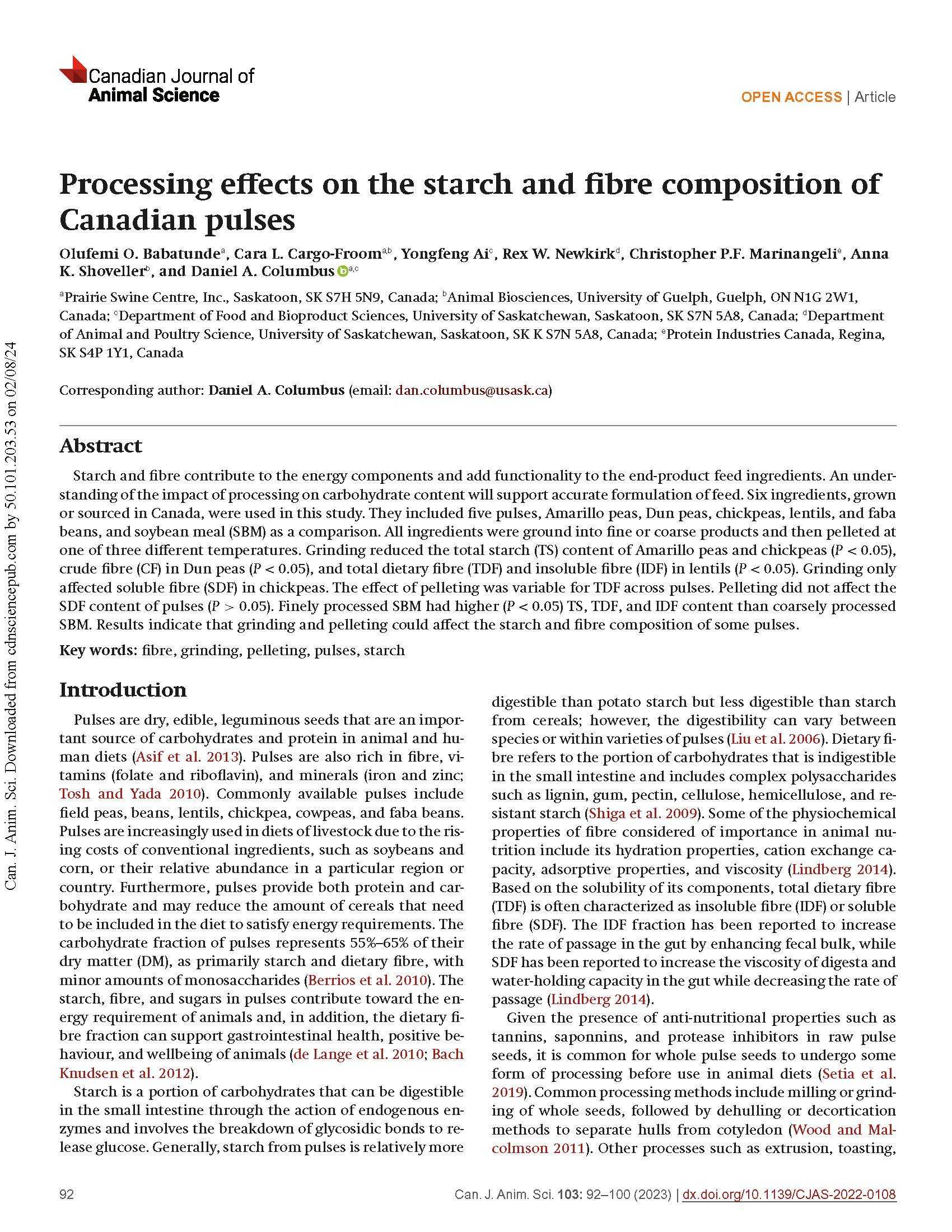
Pulses are becoming a valuable feed alternative to soybean meal in animal diets. However, there is limited information on how common feed mill processes, such as grinding and pelleting influence the starch and fiber components of pulses. It is imperative that changes in the nutrient profile of pulses due to feed processing be investigated to ensure that accurate information on the nutrient composition of pulses is included when formulating diets for livestock. The objective of this study was to characterize the effects of grinding and pelleting on the starch and fibre composition of Canadian pulses. Results of this study demonstrated that grinding and pelleting could affect the starch and fibre composition of some pulses.
Funding: Swine Innovation Porc, Saskatchewan Pulse Growers, and MITACS Accelerate
Reference: Olufemi O. Babatunde, Cara L. Cargo-Froom, Yongfeng Ai, Rex W. Newkirk, Christopher P.F. Marinangeli, Anna K. Shoveller, and Daniel A. Columbus. 2023. Processing effects on the starch and fibre composition of Canadian pulses. Canadian Journal of Animal Science. 103(1): 92-100.
Why this is important
In addition to protein, pulses can provide fibre and starch to diets, which can be important for gastrointestinal health and energy sources, respectively. Understanding two common processing methods, grinding and pelleting, affects these two macronutrients and can enhance the value proposition of pulses as animal feed by positioning them as a multi-purpose feed ingredient.
Extrusion effects on the starch and fibre composition of Canadian pulses
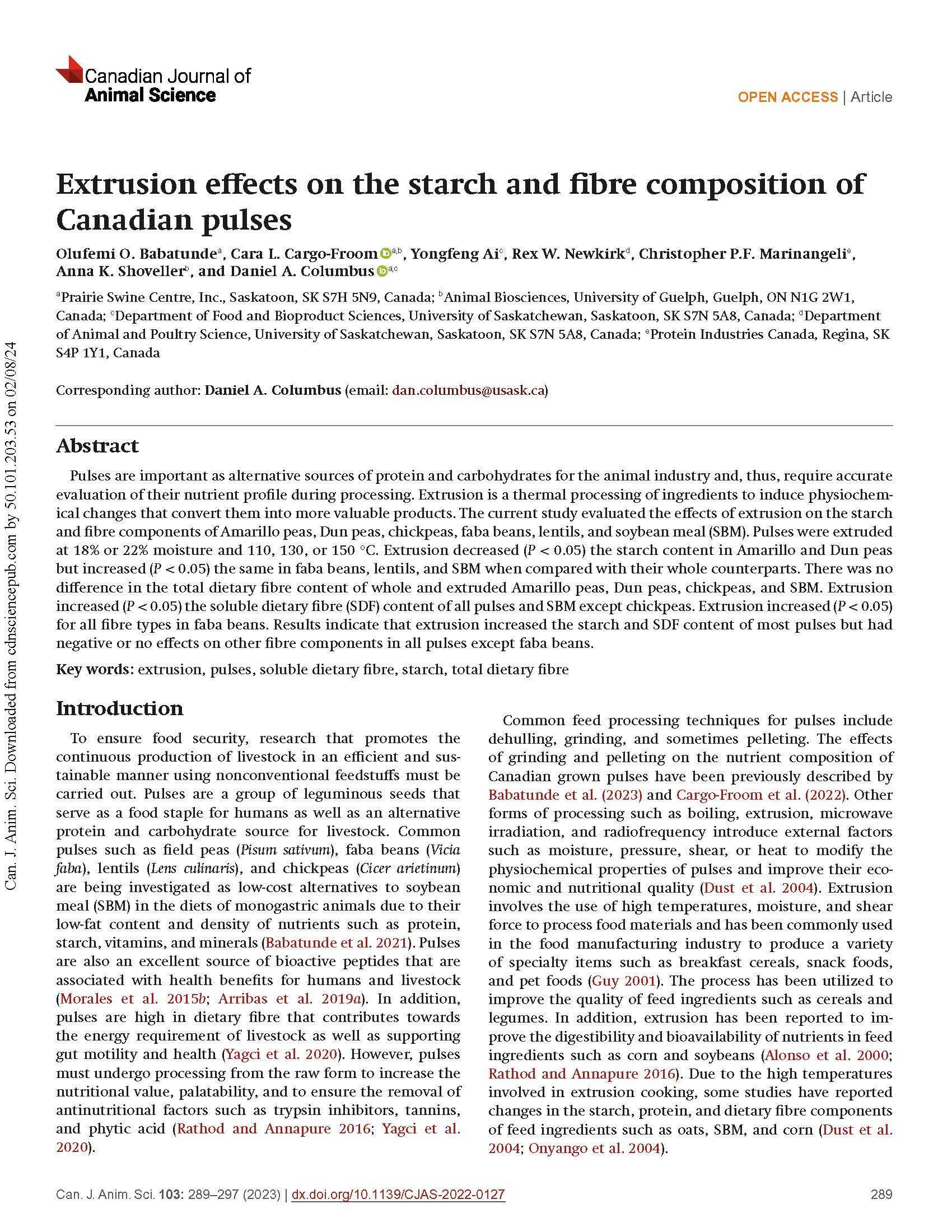
Pulses are a nutrient-dense option for livestock but require processing to remove anti-nutritional factors. Extrusion is utilized in the processing of raw ingredients, such as soybean and corn, into more valuable products with improved nutrient bioavailability and digestion for livestock. Changes in the extrusion temperature or moisture content may alter the nutrient composition of the final product. Limited studies have investigated the effects of extrusion on the nutrient composition of Canadian-sourced pulses. This study investigated the effects of extrusion processing on the starch and dietary fibre composition of Canadian pulses (field peas, faba beans, lentils, and chickpeas) and characterized any alterations of these components in the extrudates due to differences in moisture content and temperatures used during the extrusion process. In this study, extrusion increased the starch and soluble dietary fibre content of most pulses but had negative or no effects on other fiber components in all pulses except faba beans.
Funding: Swine Innovation Porc, Saskatchewan Pulse Growers, and MITACS Accelerate
Reference: Olufemi O. Babatunde, Cara L. Cargo-Froom, Yongfeng Ai, Rex W. Newkirk, Christopher P.F. Marinangeli, Anna K. Shoveller, and Daniel A. Columbus. 2023. Extrusion effects on the starch and fibre composition of Canadian pulses. Canadian Journal of Animal Science. 103(3): 289-297.
Why this is important
Extrusion technology is a common processing method that can improve the digestibility of plant foods. The ability to optimize processing conditions makes extrusion an ideal choice for manufacturing multi-component animal feeds. To increase the use of Canadian pulses as a source of protein, fibre, and starch for animal nutrition, understanding the specific effects of extrusion on Canadian plant protein ingredients will provide the sector with data and assurances to meet the needs of national and international agricultural sectors.
Determination of standardized ileal digestibility of crude protein and amino acids and digestible indispensable amino acid score of faba beans, lentils, and yellow peas fed to growing pigs
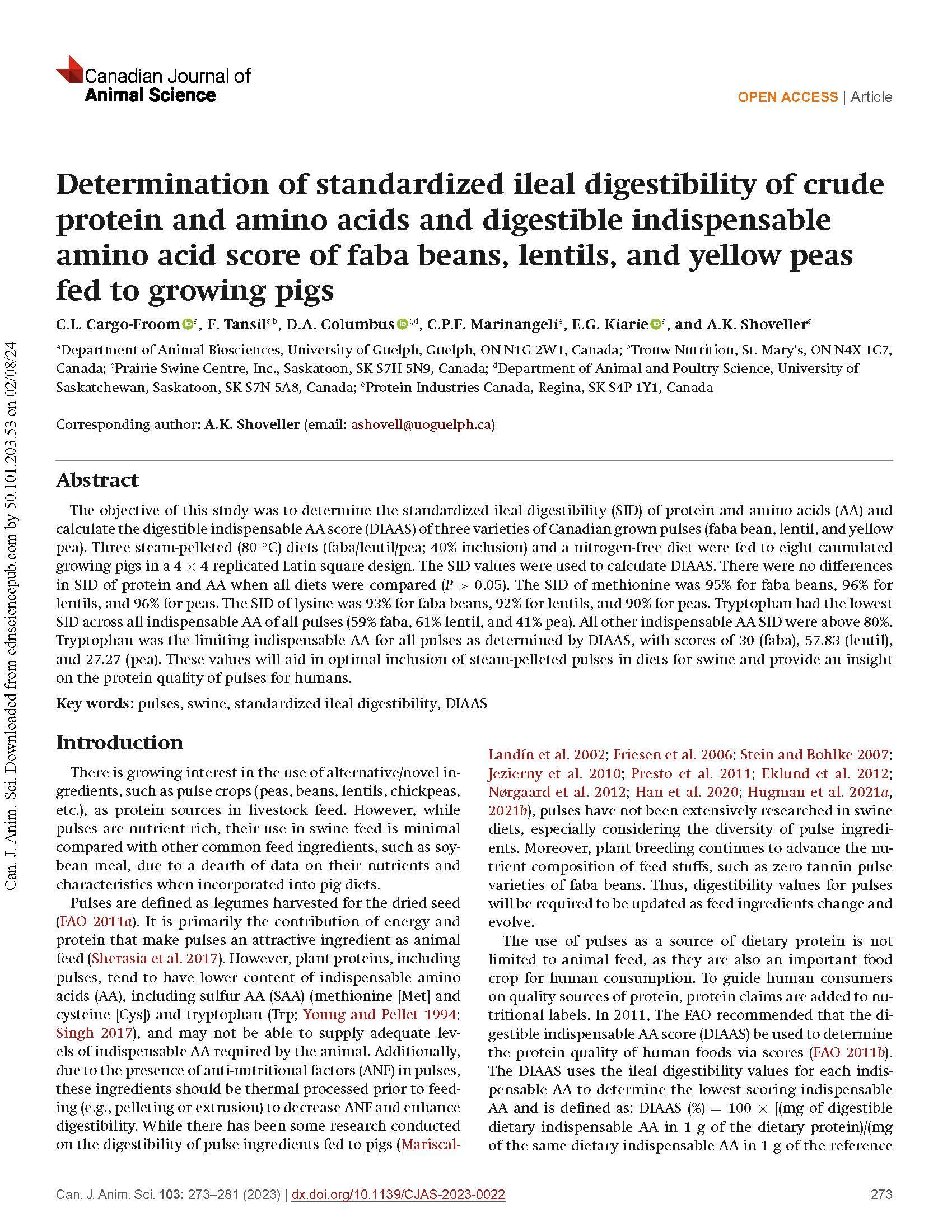
Digestibility coefficients are required for the accurate assessment of the protein quality of protein foods. Furthermore, there is growing interest in the use of alternative/novel ingredients, such as pulse crops (peas, beans, lentils, chickpeas, etc.), as protein sources in human diets and livestock feed. While pulses are nutrient-rich, their use in swine feed is minimal compared with other common feed ingredients, such as soybean meal, due to a dearth of data on their nutrients and characteristics when incorporated into pig diets. Furthermore, given the biological similarity between swine and humans, digestive data for swine can often be extrapolated to humans. There is limited literature available for ileal digestibility of crude protein and amino acids for an assortment of pulses and their respective varieties. This data is required for human and swine diets as food systems transition to include more sources of plant protein. Therefore, the objective of this study was to determine the SID values of protein and AA of steam-pelleted faba beans, lentils, and yellow peas pelleted in growing pig diets and to determine the digestible indispensable amino acid score (DIAAS) of each steam-pelleted pulse.
Funding: Swine Innovation Porc, Saskatchewan Pulse Growers, and MITACS Accelerate
Reference: C.L. Cargo-Froom, F. Tansil, D.A. Columbus, C.P.F. Marinangeli, E.G. Kiarie, and A.K. Shoveller. 2023. Determination of standardized ileal digestibility of crude protein and amino acids and digestible indispensable amino acid score of faba beans, lentils, and yellow peas fed to growing pigs. Canadian Journal of Animal Science. 103(3): 273-281.
Why this is important
As global discussions link nutritional performance and environmental sustainability, there is renewed interest in understanding the protein quality of plant protein ingredients. The DIAAS method is considered the new gold standard for determining the protein quality of food and food ingredients. Plant proteins, including Canadian pulses, are becoming more sought after as ingredients across food systems and understanding the effects of processing on parameters related to protein quality is important. The ileal digestibility data for processed Canadian pulses presents a unique value proposition for Canada’s plant protein sector that can be applied to sectors.
Effect of increasing plant protein intake on protein quality and nutrient intake of US adults
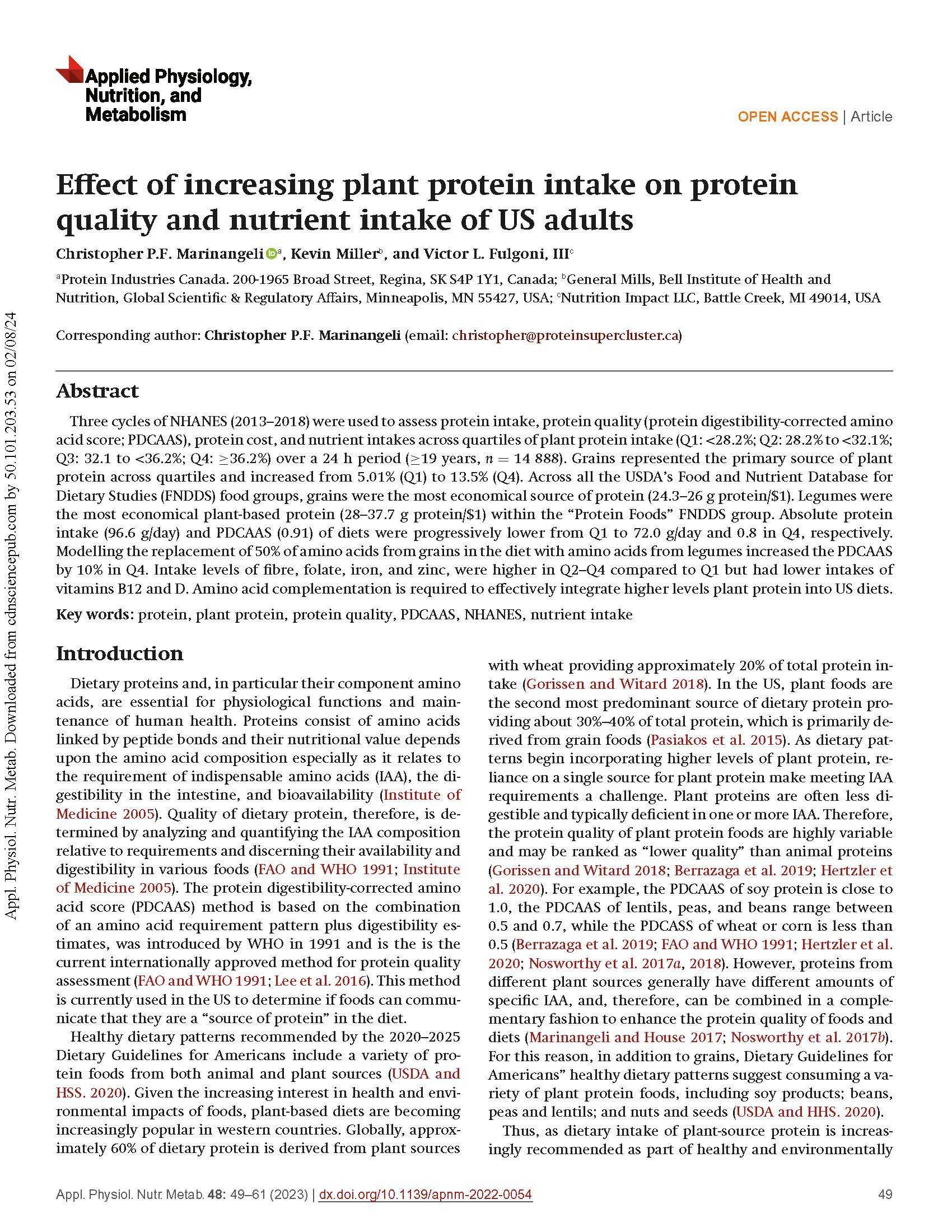
Dietary intake of plant-source protein is increasingly recommended as part of a healthy and environmentally sustainable dietary pattern. An understanding of the quality of protein will become important, especially if intakes of high-quality animal proteins are reduced. The purpose of this study was to use a large nationally representative US database of American adults to assess current protein sources, protein quality, absolute and corrected protein intake levels, and the cost of plant protein, as plant protein intake increases. An additional purpose was to model the effects of replacing amino acids from current grain protein sources with non-grain plant protein sources across increasing quartiles of plant protein intake. Results demonstrate that the protein quality decreases as the proportion of plant protein increases in the diet. Replacement of grain protein with legume protein, lentil protein or non-grain plant protein increased dietary protein quality. Since plant protein foods are increasingly recommended as part of healthy and environmentally sustainable dietary patterns various tools including protein complementarity should be included in dietary guidance and meal planning.
Funding: Pulse Canada and General Mills
Reference: Marinangeli CPF, Miller K, Fulgoni VL 3rd. Effect of increasing plant protein intake on protein quality and nutrient intake of US adults. Appl Physiol Nutr Metab. 2023 Jan 1;48(1):49-61. doi: 10.1139/apnm-2022-0054.
Why this is important
This cross-sectional analysis provides important context for shifting dietary patterns to derive more protein from plant sources. Increased use of pulses and pulse-derived ingredients, of which Canada is a major producer, can enhance the diversity of plant proteins in the diet and help meet indispensable amino acids requirements. This alongside other work will help identify knowledge gaps and find opportunities to favorably position plant protein innovation as a solution to transition to sustainable diets and food systems.
The Special Issue on “The Nutritional Value of Pulses and Whole Grains”: A Continued Endeavor to Delineate Their Benefits for Today and Addressing the Challenges of the Future
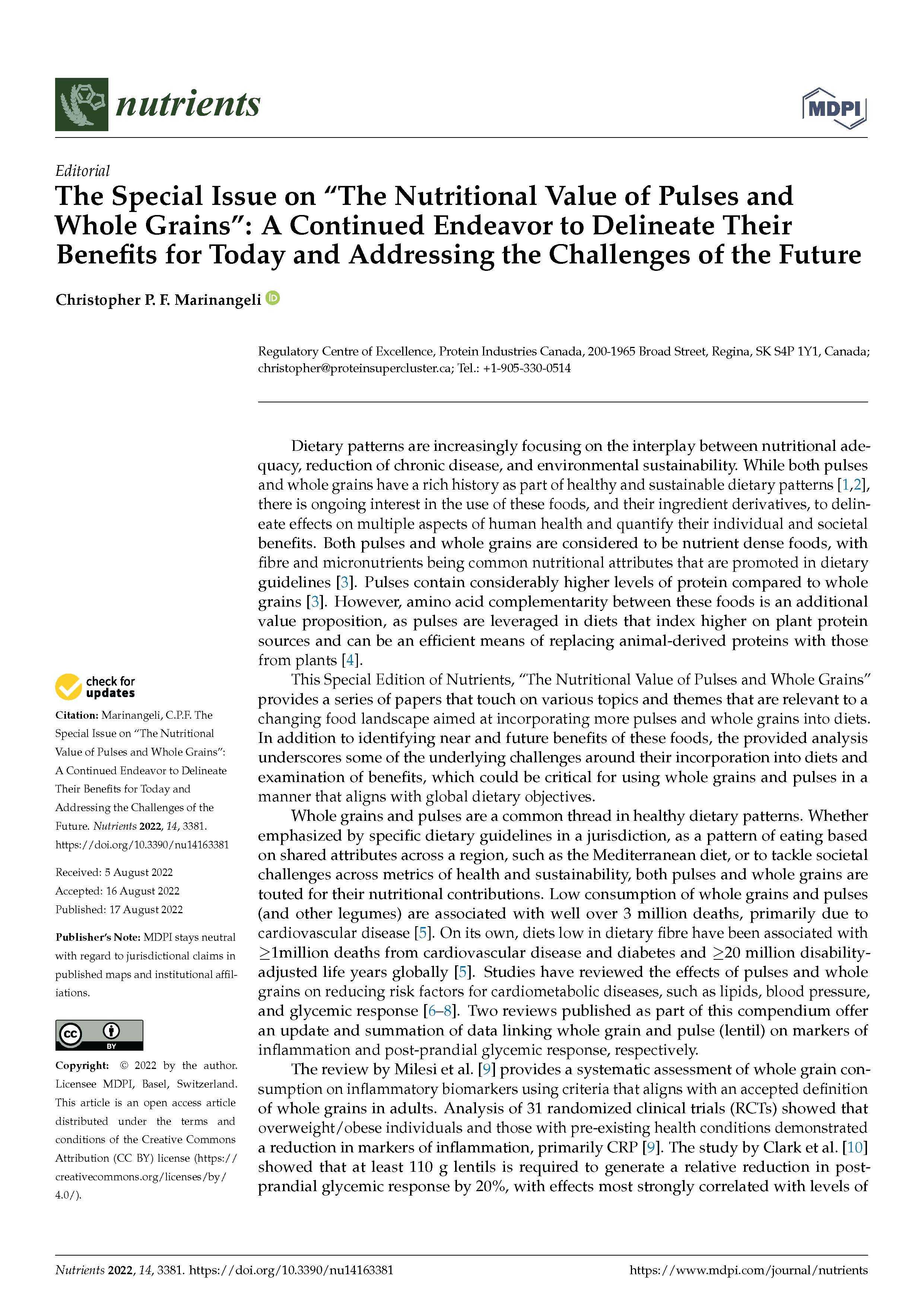
This commentary summarizes key messages and results from a compendium of studies and reviews from a Special Issues of the journal Nutritents on the “The Nutritional Value of Pulses and Whole Grains.” These foods and their ingredients can be useful for bolstering the nutritional value of manufactured food products. However, understanding the expectations of consumers could be critical for offering foods that deliver on individual and societal benefits. At the same time, a judicious examination of policies, regulations, and research methods could be a meaningful exercise to further delineate and ascertain the benefits of using these foods more liberally in the food system. Whole grains and pulses continue to be dietary assets that align with global dietary objectives across various nutrition, health, and economic goals.
Reference: Marinangeli CPF. The Special Issue on "The Nutritional Value of Pulses and Whole Grains": A Continued Endeavor to Delineate Their Benefits for Today and Addressing the Challenges of the Future. Nutrients. 2022 Aug 17;14(16):3381. doi: 10.3390/nu14163381.
Nutritional Value of Pulses and Whole Grains

Pulses and whole grains have a rich history as part of healthy and sustainable dietary patterns. There is ongoing interest in the use of these foods, and their ingredient derivatives, to delineate effects on multiple aspects of human health and quantify their individual and societal benefits. In addition to an editorial synopsis, this Special Issue “Nutritional Value of Pulses and Whole Grains” adds 11 manuscripts, including 7 studies, 2 reviews, and 2 communications that touch on a variety of topics including the efficacy of pulses and whole grains on cardiometabolic risk factors, consumer preferences and the changing retail landscape, effects on health and societal economic outcomes, and a proposed consensus to effectively integrate and evaluate whole grains and pulses within dietary patterns. These works identify near and future benefits of pulses and whole grains on health, but also underscore some of the underlying challenges around their dietary incorporation. The latter could be critical for leveraging whole grains and pulses in a manner that aligns with global dietary objectives.
Reference: Nutritional Value of Pulses and Whole Grains. Marinangeli C.P.F. (ed). 2022. MDPI Publishing.
Why this is important
This compendium provides the plant protein sector with data from a range of disciplines that will be useful for facilitating the growth of the industry. The data provided can be used as a catalyst for research and insights into understanding the value of pulses and cereals in food ecosystems and where gaps exist for future collaboration and research.
Proteins in Our Diet: Challenges in Feeding the Global Population

Animal-derived proteins including meat, dairy, and eggs have been the mainstay of Western diets and an integral part of global food production. With a projected 30% increase in the global population over the next 30 years, the optics of meeting the protein and amino acid needs of human diets have shifted the food system innovation to focus on enhancing the use of plant proteins as a feasible strategy to providing sufficient protein and indispensable amino acids. This chapter provides a basic understanding of proteins that are vital sources of nutrition and health, regulatory and policy challenges and opportunities, consumer insights and macro-level food system and climate challenges driving enhanced dietary integration of plant protein into dietary patterns.
Reference: Chapter 1. Proteins in Our Diet: Challenges in Feeding the Global Population. In. Sustainable Protein Sources 2nd Edition. 2023. Ed. Nadathur S, Wanasundara J, Scanlin L. Academic Press.
Why this is important
This research provides Canada’s plant protein industry with a comprehensive overview of the societal issues facing the world as population growth significantly increases the need to leverage plant proteins in dietary patterns. An understanding of the various domains of the transition food system will be advantageous to food innovation and create a strong value proposition of traditional and innovative plant proteins to consumers and policymakers.
Impact of Green Extraction Technologies on Plant Protein Content and Quality

Green methods for processing plant material have been garnering interest from product developers as well as consumers for their reduced environmental impact as well as enhancing the quantity and/or quality of the final protein produced. This chapter presents, where available, a discussion on the content and nutritional quality of plant proteins as determined by following extraction by alkaline extraction and isoelectric precipitation, air classification, high-pressure processing, enzyme-assisted extraction, microwave-assisted extraction, reverse micelle protein extraction, and ultrasound-assisted extraction.
Reference: Nosworthy MG and Marinangeli C.P.F. Impact of Green Extraction Technologies on Plant Protein Content and quality. In. Green Protein Processing technologies from Plants.Hernández-Álvarez, A.J., Mondor, M., Nosworthy (eds). 2023. Springer, Cham.
Why this is important
As advanced technologies emerge to enhance the environmental sustainability of processed protein foods and ingredients, an understanding of the effects on nutritional outcomes is required for risk mitigation. The ability to predict the nutritional effects of technologies that impose a lower environmental footprint compared to traditional processing will help to hasten the adoption of plant protein ingredient innovation.
The Pulse of It: Dietary Inclusion of Up to 45% Whole Pulse Ingredients with Chicken Meal and Pea Starch in a Complete and Balanced Diet Does Not Affect Cardiac Function, Fasted Sulfur Amino Acid Status, or Other Gross Measures of Health in Adult Dogs
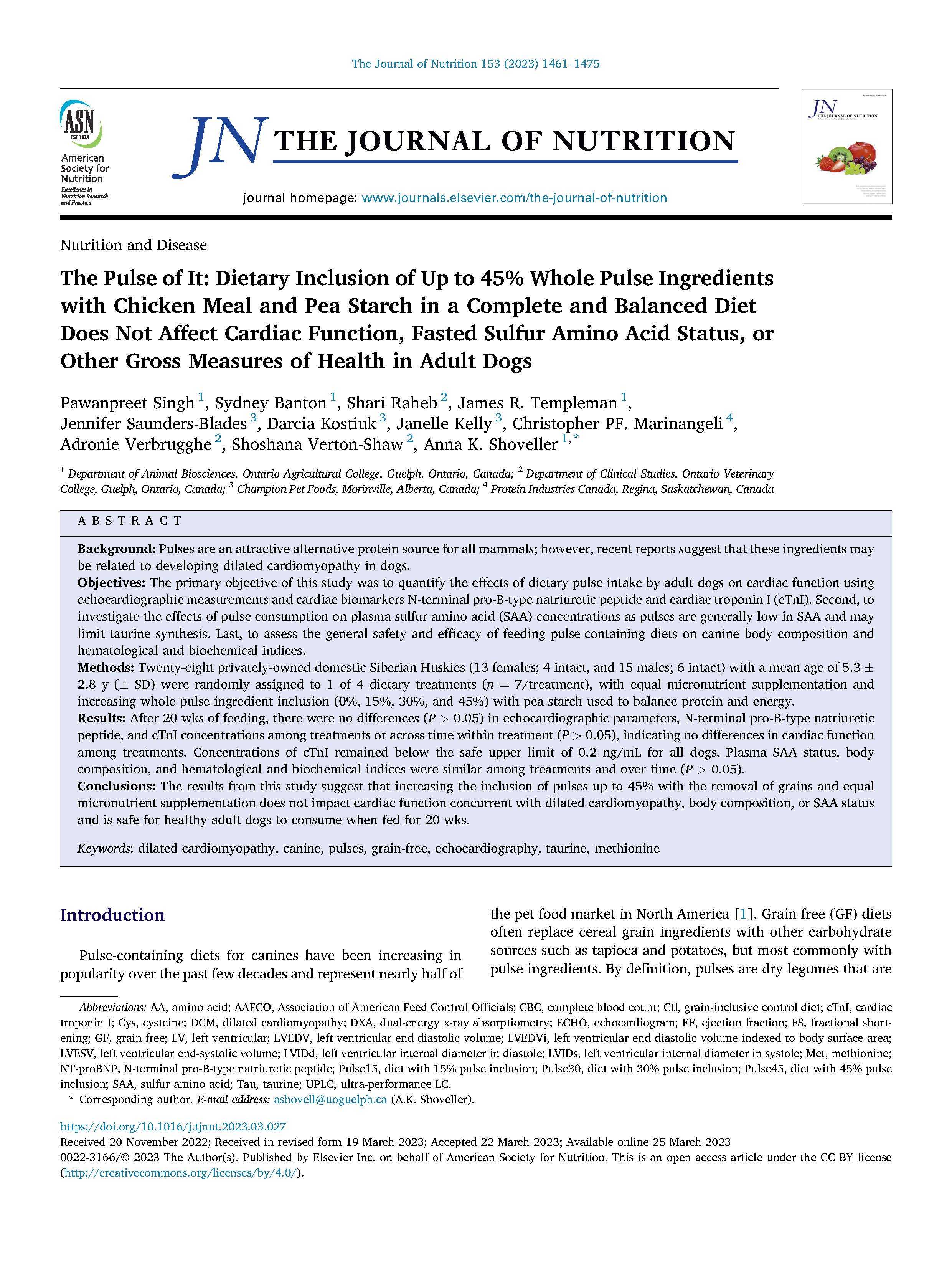
This study investigates the effects of increasing the inclusion of pulses from 0%–45% in micro, and macronutrient-balanced diets in dogs that are fed to maintain body weight BW on cardiac function, cardiac biomarkers, body composition, and haematological and biochemical indices, after 20 wks of feeding. Results showed no differences in cardiac function, sulphur amino acids status, body composition, and haematological and biochemical indices between treatments and over time. This study suggests that increasing the inclusion of pulses up to 45% with the removal of grains and equal micronutrient supplementation does not impact cardiac function concurrent with dilated cardiomyopathy, body composition, or SAA status and is safe for healthy adult dogs to consume when fed for 20 wks.
Funding: Champion Petfoods
Reference: Singh P, Banton S, Raheb S, Templeman JR, Saunders-Blades J, Kostiuk D, Kelly J, Marinangeli CP, Verbrugghe A, Verton-Shaw S, Shoveller AK. The Pulse of It: Dietary Inclusion of Up to 45% Whole Pulse Ingredients with Chicken Meal and Pea Starch in a Complete and Balanced Diet Does Not Affect Cardiac Function, Fasted Sulfur Amino Acid Status, or Other Gross Measures of Health in Adult Dogs. J Nutr. 2023 May;153(5):1461-1475.
Why this is important
Similar to human diets, plant protein ingredients are increasingly leveraged by other food sectors—the pet food industry is no exception. While pulses have been used for decades as a component of sole-source dog food diets, there is a desire to increase inclusion rates. This data provides a comprehensive safety assessment of dog foods that contain a significant proportion of protein from the Canadian pulses. These data are instrumental for instilling confidence in the pet food sector to use pulses as a source of protein and create new opportunities for the growth of Canada’s pulse industry.
Impact of Plant Protein Intakes on Nutrient Adequacy in the US
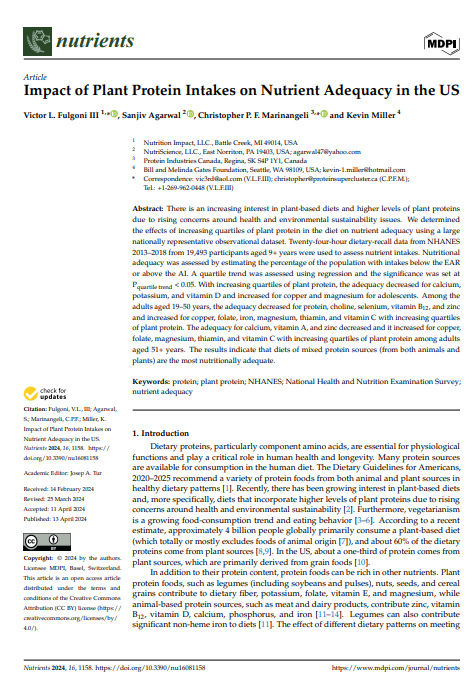
In addition to their protein content, protein foods can be rich in other nutrients. Plant protein foods, such as legumes (including soybeans and pulses), nuts, seeds, and cereal grains contribute to dietary fibre, potassium, folate, vitamin E, and magnesium, while animal-based protein sources, such as meat and dairy products, contribute zinc, vitamin B12, vitamin D, calcium, phosphorus, and iron. Given the different nutrient contents of plant-based and animal-based protein foods, the objective of this study was to determine the effects of increasing plant-based protein foods in the diet on the nutrient adequacy of not only protein/amino acids. Twenty-four-hour dietary recall data from NHANES 2013–2018 from 19,493 participants aged 9+ years were used to assess nutrient intakes. Nutritional adequacy was assessed by estimating the percentage of the population with intakes below the EAR or above the AI. The results of the current study showed that, based on current food choices in the U. S., diets of mixed protein sources, from both animals and plants, are likely the most nutritionally adequate. Depending on the age group, the highest intakes of plant protein were associated with higher levels of dietary fibre, but also associated with lower levels of protein, calcium, vitamin D, zinc, choline, vitamin B12 and zinc. The results highlight the potential nutritional challenges posed as plant protein intake increases beyond certain levels in both children and adults. Therefore, if changes in dietary recommendations, for whatever reason, lead to increased plant protein and reduced animal protein, care is needed to ensure that the adequacy of all the nutrients is achieved.
Funding: Protein Industries Canada and General Mills Inc.
Reference: Fulgoni VL 3rd, Agarwal S, Marinangeli CPF, Miller K. Impact of Plant Protein Intakes on Nutrient Adequacy in the US. Nutrients.. 2024 Apr 13;16(8):1158. doi: 10.3390/nu16081158.
Why this is important
Results from this study provide an important context for the changing food landscapes globally. Depending on how dietary patterns shift to include more plant protein foods, the types of foods, and relative intakes with other protein sources, this study provides relevant data from the perspective of today’s food environments. In addition to providing nutritional opportunities for industry, these data will inform policy and regulatory modernization efforts as well associated tools for strategically assisting consumers incorporate plant-protein into diets that deliver on nutritional expectations.
Current review of faba bean protein fractionation and its value-added utilization in foods
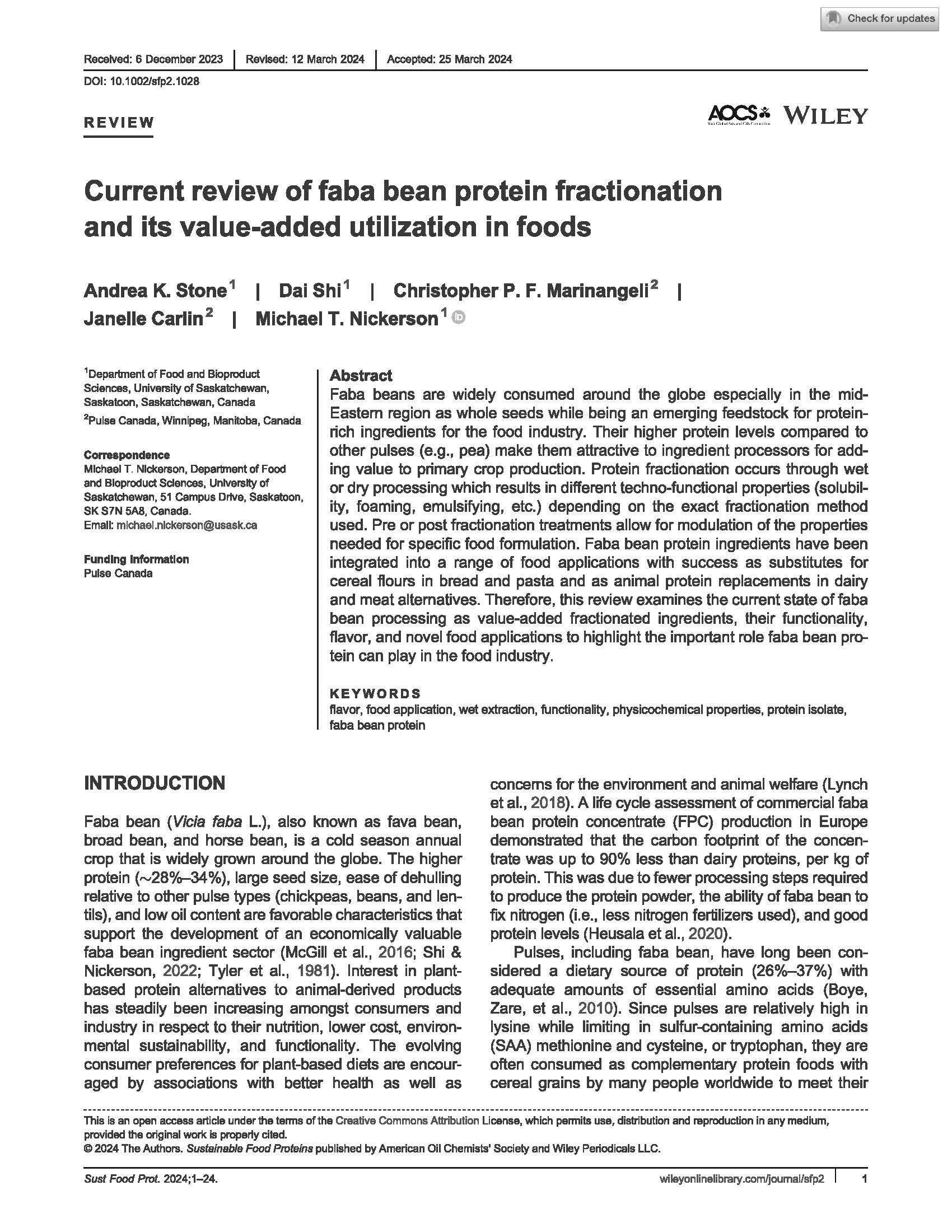
Their higher protein levels compared to other pulses (e.g., pea) make them attractive to ingredient processors for adding value to primary crop production. Protein fractionation occurs through wet or dry processing, which results in different techno-functional properties (solubility, foaming, emulsifying, etc.) depending on the exact fractionation method used. Pre- or post-fractionation treatments allow for modulation of the properties needed for specific food formulation. Faba bean protein ingredients have been integrated into a range of food applications with success as substitutes for cereal flours in bread and pasta and as animal protein replacements in dairy and meat alternatives. This review examined the state of faba bean processing as value-added fractionated ingredients, their functionality, flavour, and novel food applications to highlight the important role faba bean protein can play in the food industry.
Funding: Pulse Canada
Reference: Stone AK, Shi D, Marinangeli CPF, Carlin J, Nickerson MT. Current review of faba bean protein fractionation and its value-added utilization in foods. Sust Food Prot. 2024.
Why this is important
The faba bean sector continues to grow and expand Canada’s plant protein offerings to industry. The high concentration protein in faba bean-derived protein concentrations and isolates, and the relatively clean taste, make these ingredients a differentiating choice for food innovation. Understanding the physio-chemical properties and functionality of faba beans across food will help industry expedite the use of faba beans, and help grow Canada’s plant protein industry from farm to fork.
Cereal proteins in the human diet: Reflecting on their contributions to daily protein intake
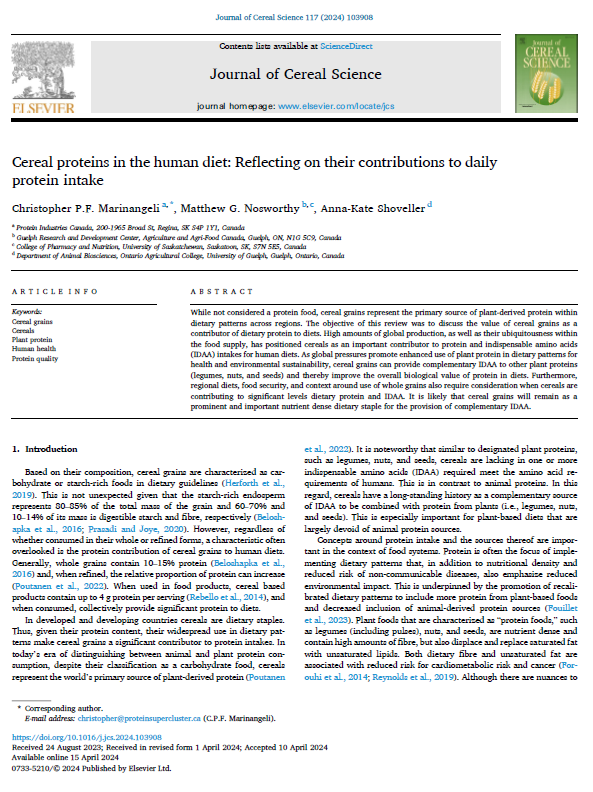
Pressures in the areas of health and environmental sustainability are re-designing dietary guidelines to increase the reliance of plant foods as sources of dietary proteins. Cereal grains represent the primary source of plant-derived protein within dietary patterns across regions. This review discusses the value of cereal grains as a contributor of dietary protein to diets. High amounts of global production, as well as their ubiquitousness within the food supply, has positioned cereals as an important contributor to protein and indispensable amino acids (IDAA) intakes for human diets. As global pressures promote enhanced use of plant protein in dietary patterns for health and environmental sustainability, cereal grains can provide complementary IDAA to other plant proteins (legumes, nuts, and seeds) and thereby improve the overall biological value of protein in diets. Furthermore, regional diets, food security, and context around the use of whole grains also require consideration when cereals are contributing to significant levels of dietary protein and IDAA. Cereal grains will likely remain as a prominent and important nutrient-dense dietary staple for the provision of complementary IDAA.
Reference: Marinangeli CPF, Nosworthy MG, and Shoveller AK. Cereal proteins in the human diet: Reflecting on their contributions to daily protein intake Journal of Cereal Science. May 2024. Vol. 17. 103908.
Why this is important
This review provides stakeholders with important context for creating innovative plant protein foods. Cereals can be an important and effective ingredient asset for meeting nutritional targets for protein complementarity when combined with plant protein foods and ingredients. Canada has a strong value proposition as a major producer of cereals. As diets shift to incorporate more plant protein, understanding the value of cereals in combination with other plant protein ingredients will fast-track innovation and more effectively meet nutritional targets.
Chasing the Transition to Plant-Based Diets: A Need for More Focus and Guidance to Facilitate Effective Dietary Changes
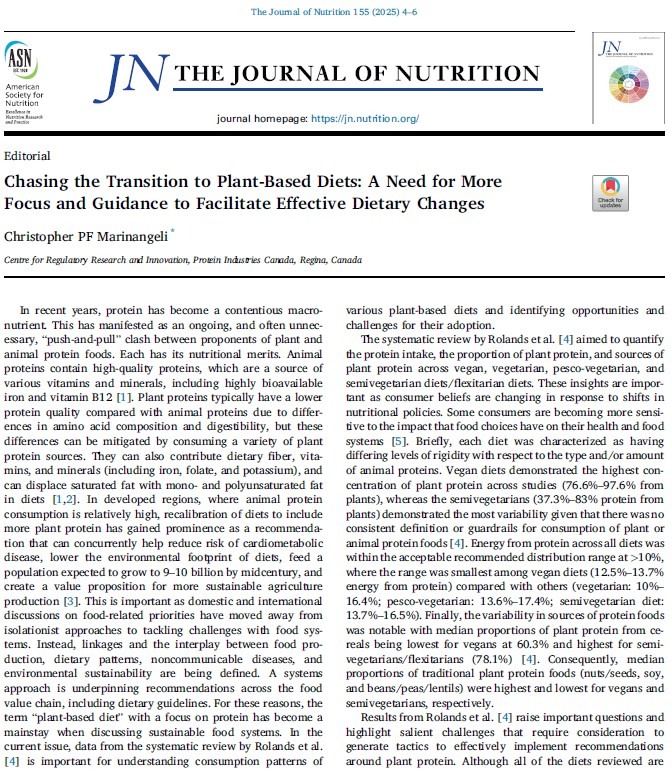
Over the last decade, there has been increasing pressure for consumers in developed countries to re-calibrate their dietary patterns to include more protein from plant foods. This is in alignment with dietary guidelines across jurisdictions, including Canada. Largely defined as plant-based dietary patterns, there has been little movement in creating food environments that meet the needs of consumers in terms of defining these patterns beyond traditional “vegan” or “vegetarian,” which to many consumers, are not aligned with their level of commitment or adherence for consumption of plant protein foods. For most consumers willing to adjust their dietary pattern, it is likely more reasonable in the short-to-medium term to align with a more flexitarian or semi-vegetarian pattern.
Using data from Rolands et al. in the same issue of the journal, this editorial highlights the important challenges impeding greater incorporation of plant protein into dietary patterns in regions where protein from terrestrial animal foods is prominent and often culturally relevant. There is no one-size-fits-all solution to this challenge, just as not all consumers will be willing to commit to a “vegan” dietary pattern. Nevertheless, there remains opportunity for impactful incremental changes that have significant personal and societal benefits. But for this to happen, there is a need for inclusiveness, clear and flexible dietary guidelines, regulations and policies that permit consumers to make healthful plant protein choices in grocery store isles.
Editorial was written under in context of results from Rolands MR, Hackl LS, Bochud M, Lê KA. Protein Adequacy, Plant Protein Proportion, and Main Plant Protein Sources Consumed Across Vegan, Vegetarian, Pescovegetarian, and Semivegetarian Diets: A Systematic Review. J Nutr. 2025 Jan;155(1):153-167. https://www.sciencedirect.com/science/article/pii/S0022316624004504?via%3Dihub
Reference: Marinangeli CPF. 2025. Chasing the Transition to Plant-Based Diets: A Need for More Focus and Guidance to Facilitate Effective Dietary Changes. Journal of Nutrition. 155. 4-6.
Why this is important
To create food environments that catalyse dietary transition, it is important that dietary definitions, clear dietary guidance, and enabling regulation and policies that facilitate dietary transitions that foster nutrition adequacy, reduction of non-communicable disease risk, and environmental sustainability, but also align with consumer’s levels of commitment.
Understanding Consumers to Enhance Demand for Sustainable Diets: Comment on “Adopting Sustainable Dietary Patterns: Effects of Food Labeling, Food Choices, and Eating Behaviors”
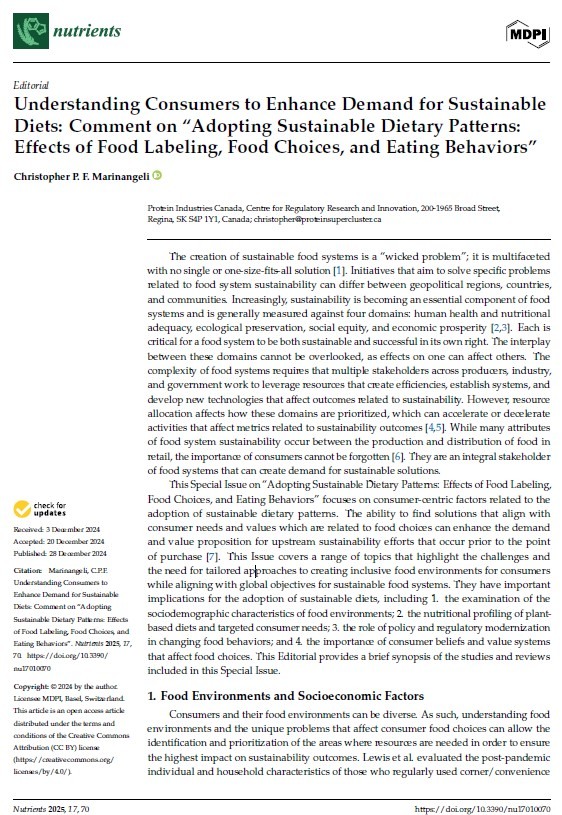
Food systems are vastly complex and ensuring their sustainability across domains of nutrition of health, economic viability, societal equity, and ecological prosperity are each challenging in their own right. This editorial summarizes 12 studies that investigate and discuss sustainable food systems under the context of consumers and creating food environments that deliver on the value proposition of “sustainability” according to their need state. The Special Issue “Adopting Sustainable Dietary Patterns, Effects of Food Labeling, Food Choices, and Eating Behaviors” presents initiatives and considerations for helping consumers support and adopt dietary patterns associated with sustainable outcomes including:
- Food environments and socioeconomic factors;
- Evaluating “plant-based” as a sustainable dietary pattern;
- Steering consumers toward sustainable food behaviours with regulation and policy; and
- Driving sustainable food choices by aligning with consumers' beliefs and values.
Reference: Marinangeli CPF. 2025. Chasing the Transition to Plant-Based Diets: A Need for More Focus and Guidance to Facilitate Effective Dietary Changes. Nutrients 2025, 17.
Why this is important
This editorial and these research projects emphasize the importance of consumers in driving the development of sustainable food systems. As innovation, particularly in the space of plant protein, continues to evolve and scale, the consumer and their needs will be important for creating and growing demand when sustainability is identified as a value proposition.
Faba bean nutrition: Macronutrients, antinutrients, and the effect of processing
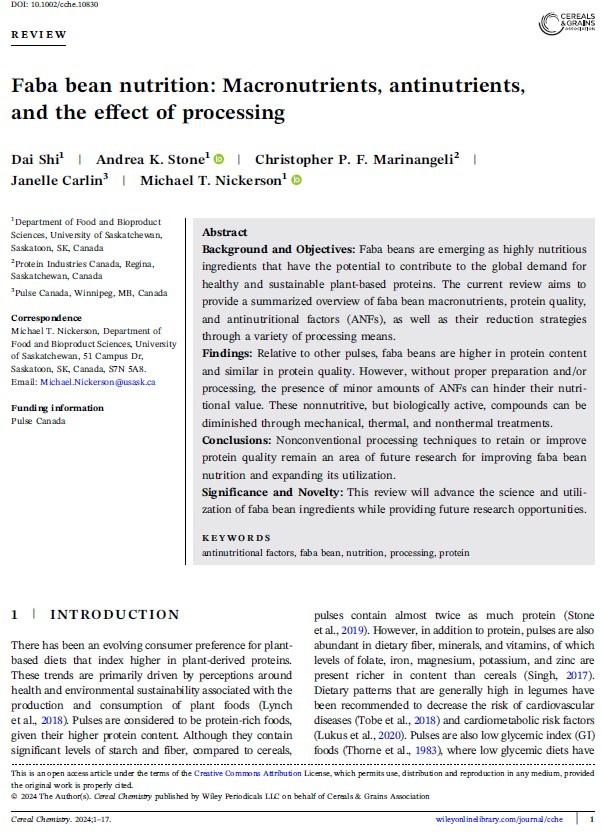
Although consumed for centuries, there is newfound interest in faba beans as a value-added ingredient in innovative plant protein foods. They are among the pulse crops with the highest concentrations of protein (>25% dry), high in fibre and other micronutrients. Their ease of fractionation and clean taste profile can make them an ideal candidate for bolstering the protein content of plant-protein foods. This review discusses the nutritional attributes of faba beans and the effects of processing on these nutrient concentrations. The effects of food processing on antinutritional factors are also discussed to derisk their use as prominent ingredients in manufactured foods.
Funding: Pulse Canada
Reference: Shi, D., Stone, A. K., Marinangeli, C. P. F., Carlin, J., & Nickerson, M. T. (2024). Faba bean nutrition: Macronutrients, antinutrients, and the effect of processing. Cereal Chemistry, 101, 1181–1197.
Why this is important
This comprehensive review provides the plant-protein food and ingredient sector with information for the efficient use of faba beans as protein, fibre, and micro-nutrient-rich ingredients in food products. Data provided on the effects of processing can inform food safety protocols and ensure the nutritional value of manufactured foods with faba-derived ingredients is realized in final product offerings.
Simulation model to assess the validity of the clinical portfolio diet score used in the PortfolioDiet.app for dietary self-tracking: a secondary analysis of a randomized controlled trial in hyperlipidemic adults
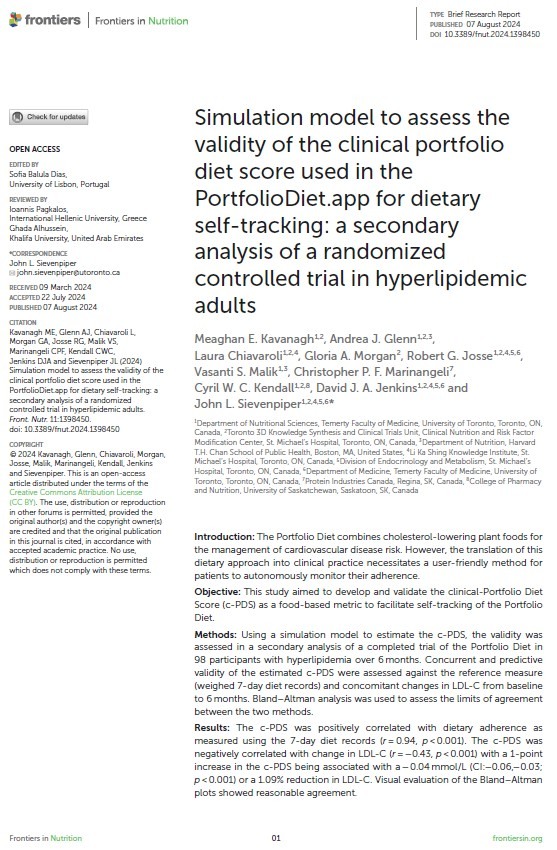
The Portfolio Diet is a dietary pattern that has been consistently shown to lower cholesterol levels, a known risk factor for cardiovascular disease. Developed in Canada, the Portfolio Diet emphasized plant protein as one of its five dietary pillars, which also include viscous fibre, plant sterols, nuts and seeds, and mono-unsaturated fat. To evaluate compliance of the Portfolio Diet outside the clinical setting, a scoring system was developed to rapidly assess compliance to the pattern for maximizing. To manage adherence, this study validated the clinical-Portfolio Diet Score (c-PDS) against seven-day food records. Results demonstrated a significant positive correlation of the c-PDS with food records (r=0.94, p<0.001), and a negative correlation with change in LDL-cholesterol (r= -0.43, p<0.001), the type of cholesterol associated with heart disease. Results of this study demonstrate that the c-PDS can be used by healthcare providers, but also future consumer-facing tools, such as app platforms, to rapidly assess the plant-based portfolio diet as an efficacious tool to lower cholesterol.
Funding: Canadian Institutes of Health Research (CIHR) ; The Diet, Digestive tract, and Disease (3D) Centre; Toronto 3D Knowledge Synthesis and Clinical Trials Foundation; Canada Research Chair Endowment; PSI Graham Farquharson Knowledge Translation Fellowship; Canadian Diabetes Association Clinician Scientist Award; CNS New Investigator Partnership Prize; Banting & Best Diabetes Centre Sun Life Financial New Investigator Award.
Reference: Kavanagh ME, Glenn AJ, Chiavaroli L, Morgan GA, Josse RG, Malik VS, Marinangeli CPF, Kendall CWC, Jenkins DJA, Sievenpiper JL. Simulation model to assess the validity of the clinical portfolio diet score used in the PortfolioDiet.app for dietary self-tracking: a secondary analysis of a randomized controlled trial in hyperlipidemic adults. Front Nutr. 2024 Aug 7;11:1398450.
Why this is important
This study adds to the already large body of evidence demonstrating the utility of the Portfolio Diet as an effective plant-based dietary protein, that emphasizes the use of plant protein. This validation provides the necessary data to integrate the Portfolio Diet into clinical practice, where the dietary pattern is already acknowledged in clinical practice guidelines. This data also permits the use of the c-PDS as a simple tool to be integrated into new platforms for assessing adherence to cholesterol-lowering efficacy in real-world settings. This enhances the value proposition of plant protein and other food groups that make up Portfolio Dietary pattern.
Effects of Extracted Pulse Proteins on Lipid Targets for Cardiovascular Risk Reduction: Systematic Review and Meta-Analysis of Randomized Controlled Trials
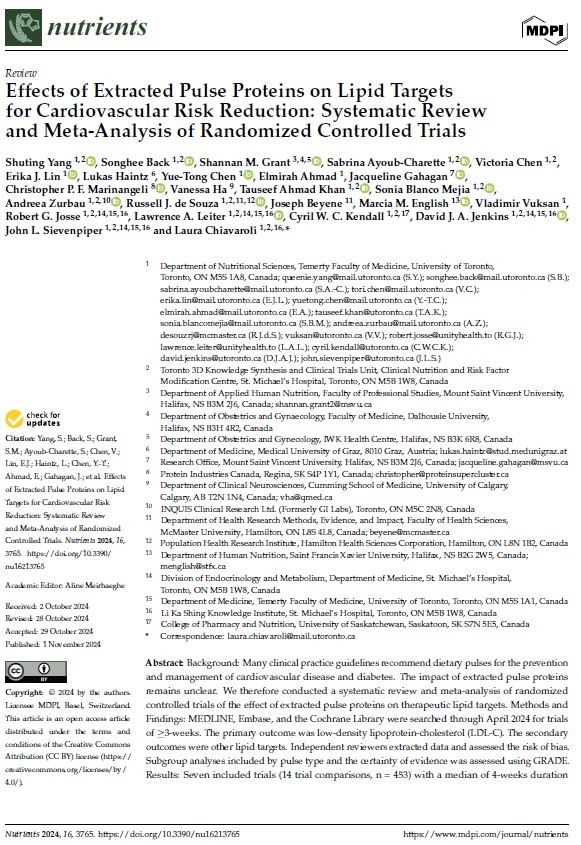
Protein from pulses is increasingly extracted for use in innovative plant protein foods. Although whole pulses are often emphasized for their use in dietary patterns that reduce risk or manage cardiovascular and diabetes, the effects of extracted pulse proteins are lesser known. This systematic review and meta-analysis evaluated randomized clinical trials on the effects of extracted pulse proteins on lipid levels in humans. The results demonstrated that across a median time of four weeks and 35 g/day, extracted pulse proteins lowered LDL cholesterol by 0.23 mmol/L in patients with and without hypercholesterolemia.
Funding: S Banting and Best Diabetes Centre Charles Hollenberg Summer Studentship; Internal sabbatical research grants (Mount Saint Vincent University), Undergraduate Research Opportunity Program (Department of Nutritional Sciences, University of Toronto); Toronto 3D Knowledge Synthesis and Clinical Trials Foundation; Canadian Institute of Health Research (CIHR); Government of Canada through the Canada Research Chair Endowment.
Reference: Yang S, Back S, Grant SM, Ayoub-Charette S, Chen V, Lin EJ, Haintz L, Chen YT, Ahmad E, Gahagan J, Marinangeli CPF, Ha V, Khan TA, Mejia SB, Zurbau A, de Souza RJ, Beyene J, English MM, Vuksan V, Josse RG, Leiter LA, Kendall CWC, Jenkins DJA, Sievenpiper JL, Chiavaroli L. Effects of Extracted Pulse Proteins on Lipid Targets for Cardiovascular Risk Reduction: Systematic Review and Meta-Analysis of Randomized Controlled Trials. Nutrients. 2024 Nov 1;16(21):3765.
Why this is important
Understanding the effects of innovative plant-protein ingredients is important. These aggregated analyses can be critical for dietary factors, including plant-protein ingredients, to gain prominence in clinical practice guidelines for dietary patterns for chronic disease prevention and management, but also Canada’s Food Guide. Given that these guidelines are evidence-based, these analyses are required to support new food platforms and their inclusion in dietary patterns that align with national nutritional policies and regulatory modernization efforts.
Front-of-package food labels: A path to healthier choices

In 2022, Health Minister Jean-Yves Duclos announced new food labelling in Ottawa in June. Pre-packaged foods with high levels of saturated fat, sugar or sodium will require front-of-package nutrition labels starting in 2026. Nutrition labels on food packaging will soon appear in grocery stores, and full compliance set for January 2026.
Authors: Zahra Saghafi (PhD Candidate, University of Guelph), Christopher Marinangeli, PhD, RD.
Why this is important
This regulation has a number of implications, not only for consumers, but also food manufactures. These refreshed labels provide consumers with clearer nutrition guidelines by simplifying and prominently displaying key nutritional information for sodium, saturated fat and sugar as nutrients to avoid.
Strengthening Policy and Regulation for Sustainable, Healthy Diets in a Changing Food System webinar

Use code "POLICY" to access the webinar recording for free.
This webinar explores the opportunities and challenges for governments to strengthen policy coherence and regulatory oversight to encourage businesses to develop and market novel food and beverage products that support sustainable healthy dietary patterns to advance personal and planetary health. The speakers examine case studies of countries that have recently updated national food-based dietary guidelines that include plant-based dietary patterns, and the policies and regulatory oversight needed to ensure the safety and healthfulness of novel proteins (plant, animal and hybrid) to meet human needs while supporting environmental sustainability and climate mitigation goals.
State of the Science: Protein, Satiety, and Body Weight

This webinar delivers an overview of dietary recommendations of protein, current protein intakes, various sources of protein and how it’s labelled on packaging. This session will also examine the latest research on protein intake and its impact on weight loss and weight maintenance, including the science behind protein's effect on satiety, exploring how it helps regulate appetite, impacts metabolism, and influences lean muscle mass. The session will conclude with emerging research on behaviour modifications such as protein timing and exercise, and where more research is needed.
Canadian Food Regulations: Are they barriers or facilitators to food innovations in Canada?

Over the past decade, food and food systems have emerged as key to tackling non-communicable diseases, sustainability, and food security. This has spurred major investments in technologies that transform how we produce and consume food.
Yet, regulation and policy remain major barriers to innovation, access, and identifying foods that support healthy diets.
In this episode, Dr. Yan and Dr. Godefroy discuss regulation and policy as a barrier and facilitator to addressing food system challenges, with a primary focus on food manufacturing and consumers as targets for food system modernization.
Leading contributor to the work of the CRRI

Christopher Marinangeli
Director of the Centre for Regulatory Research and Innovation
Protein Industries Canada
Chris has a PhD in Food and Nutrition Science from the University of Manitoba, and is a registered dietitian with over 10 years of experience across consumer packaged goods and the Canadian agriculture sector.
His expertise includes national and international food regulations, regulatory affairs, and consumer insights and equity for developing strategies and tactics to meet business needs.
Prior positions include that of Senior Director of Research and Regulatory Affairs at Pulse Canada and Senior Manager of Nutritional Science and Regulatory Affairs at Kellogg Canada, board member for the Canadian Federation of Dietetic Research (CFDR) and member of the Canadian Advisory Committee for ILSI North America.
He currently serves on the Scientific Advisory Committee for CFDR and jury member for Agriculture Agri-food Canada’s Food Waste Reduction Challenge: Novel Technologies.
